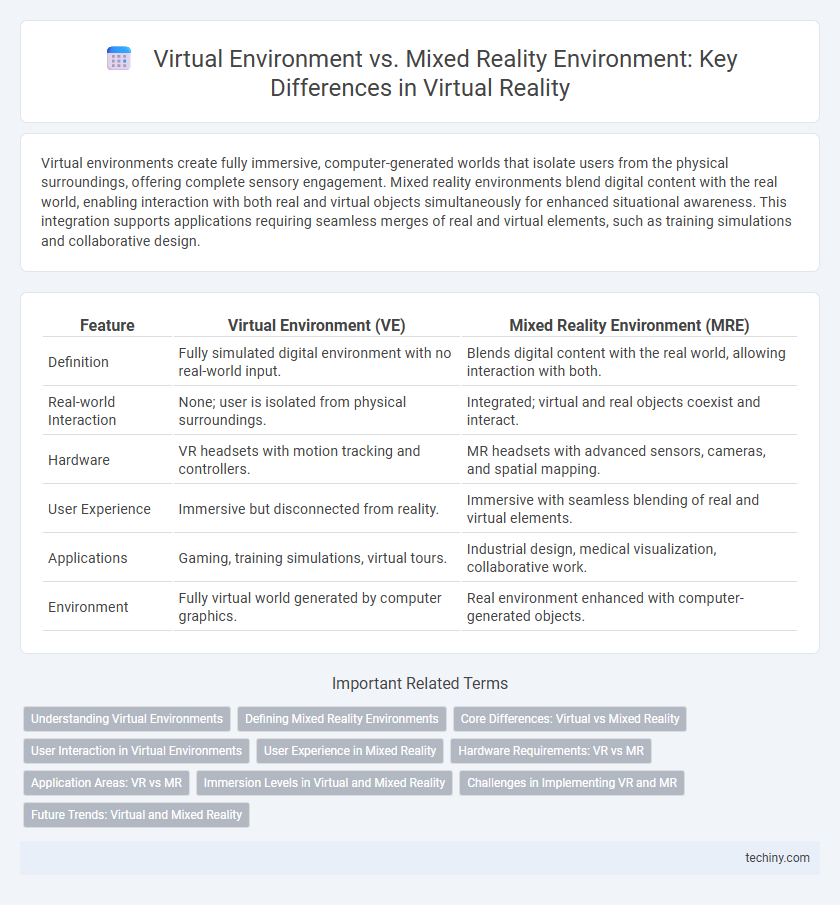Virtual environments create fully immersive, computer-generated worlds that isolate users from the physical surroundings, offering complete sensory engagement. Mixed reality environments blend digital content with the real world, enabling interaction with both real and virtual objects simultaneously for enhanced situational awareness. This integration supports applications requiring seamless merges of real and virtual elements, such as training simulations and collaborative design.
Table of Comparison
| Feature | Virtual Environment (VE) | Mixed Reality Environment (MRE) |
|---|---|---|
| Definition | Fully simulated digital environment with no real-world input. | Blends digital content with the real world, allowing interaction with both. |
| Real-world Interaction | None; user is isolated from physical surroundings. | Integrated; virtual and real objects coexist and interact. |
| Hardware | VR headsets with motion tracking and controllers. | MR headsets with advanced sensors, cameras, and spatial mapping. |
| User Experience | Immersive but disconnected from reality. | Immersive with seamless blending of real and virtual elements. |
| Applications | Gaming, training simulations, virtual tours. | Industrial design, medical visualization, collaborative work. |
| Environment | Fully virtual world generated by computer graphics. | Real environment enhanced with computer-generated objects. |
Understanding Virtual Environments
Virtual environments simulate fully immersive digital worlds, allowing users to interact within a computer-generated space without physical references. Mixed reality environments blend virtual elements with the physical world, enabling real-time interaction between digital objects and real surroundings. Understanding virtual environments involves recognizing the complete sensory immersion they provide, distinguishing them from the hybrid experience offered by mixed reality.
Defining Mixed Reality Environments
Mixed reality environments blend physical and digital elements, allowing real and virtual objects to coexist and interact in real time. Unlike purely virtual environments that immerse users in completely computer-generated worlds, mixed reality integrates spatial mapping and sensor technology to anchor digital content seamlessly within the physical space. This fusion enables dynamic interactions and contextual awareness, enhancing user experience beyond traditional virtual reality limitations.
Core Differences: Virtual vs Mixed Reality
A virtual environment fully immerses users in a digitally created world without real-world interaction, relying on headsets and sensors for complete sensory isolation. Mixed reality blends physical and digital elements, allowing users to see and interact with virtual objects overlaid on their actual surroundings using advanced spatial mapping and real-time environmental integration. The core difference lies in virtual reality's total immersion contrasted with mixed reality's interactive overlay, which enhances real-world experiences rather than replacing them.
User Interaction in Virtual Environments
User interaction in virtual environments relies on fully immersive experiences where users engage with computer-generated settings through devices like headsets and controllers, allowing complete sensory immersion. Mixed reality environments blend physical and digital elements, enabling users to interact simultaneously with real-world objects and virtual overlays, enhancing situational awareness and real-time responsiveness. Virtual environments typically prioritize avatar-based navigation and interaction within isolated digital worlds, while mixed reality systems emphasize seamless integration of tangible and virtual components to enrich user engagement.
User Experience in Mixed Reality
Mixed reality environments enhance user experience by seamlessly blending physical and digital elements, allowing intuitive interaction with both real-world and virtual objects simultaneously. This integration provides a more immersive and context-aware experience compared to fully virtual environments, where users are confined to a completely synthetic setting. Real-time spatial mapping and gesture recognition in mixed reality improve usability and engagement by adapting to users' immediate surroundings.
Hardware Requirements: VR vs MR
Virtual reality (VR) environments demand high-performance headsets with immersive displays, motion tracking sensors, and powerful GPUs to render fully digital worlds. Mixed reality (MR) setups require advanced spatial mapping hardware, depth sensors, and transparent displays to overlay virtual objects onto the real world accurately. MR systems often combine VR hardware features with additional environmental sensing components, resulting in more complex and resource-intensive hardware requirements compared to VR.
Application Areas: VR vs MR
Virtual environments excel in immersive gaming, simulation training, and virtual tourism, providing fully digital experiences that enhance user engagement with realistic scenarios. Mixed reality environments integrate digital objects into the real world, making them ideal for industrial design, medical visualization, and collaborative remote work by enabling seamless interaction between physical and virtual elements. Both technologies drive innovation in education and entertainment, but MR's ability to blend real and virtual contexts expands practical applications in professional and creative fields.
Immersion Levels in Virtual and Mixed Reality
Virtual environments offer full immersion by replacing the real world entirely with a computer-generated setting, creating an experience where users interact solely within a virtual space. Mixed reality environments blend real and virtual elements, allowing users to perceive and interact with both physical and digital objects simultaneously, resulting in a heightened sense of presence and contextual awareness. The immersion level in virtual reality is primarily sensory and visual, while mixed reality enhances immersion through spatial mapping and real-time interaction with real-world surroundings.
Challenges in Implementing VR and MR
Virtual environments in VR require high computational power to render immersive, fully digital worlds, often facing latency and hardware limitations that affect user experience. Mixed reality environments pose integration challenges, as they must seamlessly blend virtual objects with real-world settings, demanding precise spatial mapping and advanced sensor calibration. Both VR and MR implementations struggle with user interface design and real-time interaction, complicating development and scalability efforts.
Future Trends: Virtual and Mixed Reality
Virtual environments create fully immersive digital worlds primarily for gaming, training, and simulations, while mixed reality environments blend physical and digital elements for interactive experiences in fields like healthcare and design. Future trends emphasize enhanced spatial computing, AI-driven content personalization, and wireless, lightweight hardware to blur the boundaries between virtual and real-world interactions. Advancements in 5G connectivity and cloud-based rendering will enable seamless, high-fidelity mixed reality applications across industries, accelerating adoption and innovation.
Virtual environment vs Mixed reality environment Infographic

 techiny.com
techiny.com